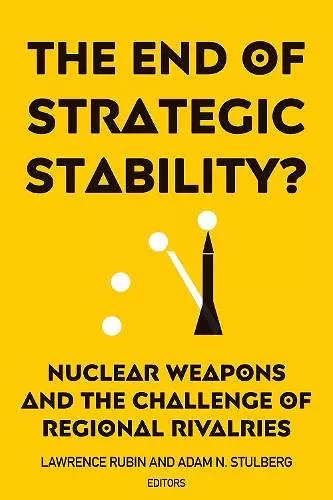The End of Strategic Stability?
Nuclear Weapons and the Challenge of Regional Rivalries
Adam N Stulberg editor Lawrence Rubin editor
Format:Paperback
Publisher:Georgetown University Press
Published:3rd Sep '18
Should be back in stock very soon
This paperback is available in another edition too:
- Hardback£96.00(9781626166028)

"By providing a detailed road map of how the world’s current, and potential, nuclear weapon states conceive of strategic stability, the authors have initiated a conversation that needs to be continued now and in the future."
During the Cold War, many believed that the superpowers shared a conception of strategic stability, a coexistence where both sides would compete for global influence but would be deterred from using nuclear weapons. In actuality, both sides understood strategic stability and deterrence quite differently. Today’s international system is further complicated by more nuclear powers, regional rivalries, and nonstate actors who punch above their weight, but the United States and other nuclear powers still cling to old conceptions of strategic stability. The purpose of this book is to unpack and examine how different states in different regions view strategic stability, the use or non-use of nuclear weapons, and whether or not strategic stability is still a prevailing concept. The contributors to this volume explore policies of current and potential nuclear powers including the United States, Russia, China, India, Iran, Israel, Pakistan, and Saudi Arabia. This volume makes an important contribution toward understanding how nuclear weapons will impact the international system in the twenty-first century and will be useful to students, scholars, and practitioners of nuclear weapons policy.
This book makes a very thoughtful contribution to the discussion of new security challenges facing the world when the members of the nuclear club are growing and established members are refining their arsenals. . . . This book should definitely be on the reading list of every graduate seminar on international security, and both academics and policymakers must grapple with the weighty questions raised in this book. * H-Diplo *
This book deserves a place on the bookshelf for scholars and practitioners who will find in its well curated pages an insightful framework to further the discussion on formulating effective multi-domain deterrence. * Air & Space Power Journal (ASPJ) *
Read as a cross-national treatment of strategic stability, the volume has much to offer practitioners interested in the subject. The editors admit that the conception of strategic stability varies from state to state, but the authors do an excellent job framing and putting each state’s understanding in context. The book also has much to offer the more general reader who is interested in how various states think about nuclear doctrine today. * Choice *
Makes an important and timely contribution towards our understanding of just how nuclear weapons will impact the international system in the twenty-first century. and will be useful to students, scholars, and practitioners of nuclear weapons policy. * Midwest Book Review *
The insights of the volume provide a much-needed antidote to conventional approaches to security studies, where concepts like strategic stability and deterrence are taken for granted and applied wholesale to wildly different contexts. * Perspectives on Politics *
The insights of the volume provide a much-needed antidote to conventional approaches to security studies, where concepte like strategic stability and deterrence are taken for granyed and applied wholesale to wildly different contexts. * Perspectives on Politics *
By providing a detailed road map of how the world’s current, and potential, nuclear weapon states conceive of strategic stability, the authors have initiated a conversation that needs to be continued now and in the future. * Journal of European, Middle East & African Affairs *
ISBN: 9781626166035
Dimensions: unknown
Weight: 454g
328 pages